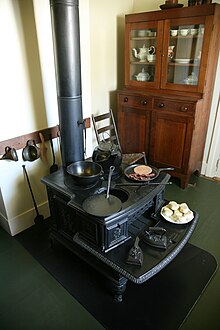
A wood-burning stove (or wood burner or log burner in the UK) is a heating or cooking appliance capable of burning wood fuel, often called solid fuel, and wood-derived biomass fuel, such as sawdust bricks. Generally the appliance consists of a solid metal (usually cast iron or steel) closed firebox, often lined by fire brick, and one or more air controls (which can be manually or automatically operated depending upon the stove). The first wood-burning stove was patented in Strasbourg in 1557. This was two centuries before the Industrial Revolution, so iron was still prohibitively expensive. The first wood-burning stoves were high-end consumer items and only gradually became used widely.[1][a]
The stove is connected by ventilating stove pipe to a suitable flue, which will fill with hot combustion gases once the fuel is ignited. The chimney or flue gases must be hotter than the outside temperature to ensure combustion gases are drawn out of the fire chamber and up the chimney.
Wood burners can triple the level of harmful indoor air pollution.[2] In the 2010s, 61,000 premature deaths were attributable annually to ambient air pollution from residential heating with wood and coal in Europe, with an additional 10,000 attributable deaths in North America.[3] The use of wood-burning stoves in Africa is associated with a large number of deaths each year, approximately 463,000.[4] This high number of deaths is due to the inhalation of toxic smoke emitted by improperly vented stoves, and contains substances harmful to health. In addition, reliance on wood as an energy source also contributes to deforestation and climate change, although the CO2 emissions from wood-derived fuels are the same as emissions from natural decay.
- ^ "Wood-burning stove".
1557: First patent issued for a wood conserving stove in Strasbourg.
- ^ "Wood burners triple harmful indoor air pollution, study finds". TheGuardian.com. 18 December 2020.
1557: First patent issued for a wood conserving stove in Strasbourg.
- ^ "Residential heating with wood and coal: health impacts and policy options in Europe and North America" (PDF). 2015.
- ^ Khavari, Babak; Ramirez, Camilo; Jeuland, Marc; Fuso Nerini, Francesco (2023-01-12). "A geospatial approach to understanding clean cooking challenges in sub-Saharan Africa". Nature Sustainability. 6 (4): 447–457. doi:10.1038/s41893-022-01039-8. ISSN 2398-9629. S2CID 255875387.
Cite error: There are <ref group=lower-alpha> tags or {{efn}} templates on this page, but the references will not show without a {{reflist|group=lower-alpha}} template or {{notelist}} template (see the help page).